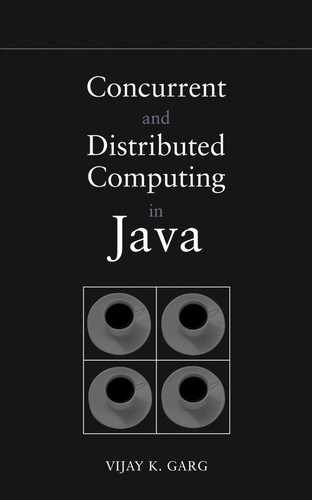Preface
This book is designed for a senior undergraduate-level course or an introductory graduate-level course on concurrent and distributed computing. This book grew out of my dissatisfaction with books on distributed systems (including books authored by me) that included pseudocode for distributed algorithms. There were two problems with pseudocode. First, pseudocode had many assumptions hidden in it making it more succinct but only at the expense of precision. Second, translating pseudocode into actual code requires effort and time, resulting in students never actually running the algorithm. Seeing the code run lends an extra level of confidence in one’s understanding of the algorithms.
It must be emphasized that all of the Java code provided in this book is for educational purposes only. I have deliberately avoided error checking and other software engineering principles to keep the size of the code small. In the majority of cases, this led to Java code, that kept the concepts of the algorithm transparent.
Several examples and exercise problems are included in each chapter to facilitate classroom teaching. I have made an effort to include some programming exercises with each chapter.
I would like to thank the following people for working with me on various projects discussed in this book: Craig Chase (weak predicates), Om Damani (message logging), Eddy Fromentin (predicate detection), Joydeep Ghosh (global computation), Richard Kilgore (channel predicates), Roger Mitchell (channel predicates), Neeraj Mittal (predicate detection and control, slicing, self-stabilization, distributed shared memory), Venkat Murty (synchronous ordering), Michel Raynal (control flow properties, distributed shared memory), Alper Sen (slicing), Chakarat Skawratonand (vector clocks), Ashis Tarafdar (message logging, predicate control), Alexander Tomlinson (global time, mutual exclusion, relational predicates, control flow properties) and Brian Waldecker (weak and strong predicates). Anurag Agarwal, Arindam Chakraborty, Selma Ikiz, Neeraj Mittal, Sujatha Kashyap, Vinit Ogale, and Alper Sen reviewed parts of the book. I owe special thanks to Vinit Ogale for also helping me with figures.
I thank the Department of Electrical and Computer Engineering at The University of Texas at Austin, where I was given the opportunity to develop and teach courses on concurrent and distributed systems. Students in these courses gave me very useful feedback.
I was supported in part by many grants from the National Science Foundation over the last 14 years. Many of the results reported in this book would not have been discovered by me and my research group without that support. I also thank John Wiley & Sons, Inc. for supporting the project.
Finally, I thank my parents, wife and children. Without their love and support, this book would not have been even conceived.
There are many concurrent and distributed programs in this book. Although I have tried to ensure that there are no “bugs” in these programs, some are, no doubt, still lurking in the code. I would be grateful if any bug that is discovered is reported to me. The list of known errors and the supplementary material for the book will be maintained on my homepage:
http://www.ece.utexas.edu/"garg
Included in the Website is a program that allows animation of most of the algorithms in the book. It also includes all the source code given in the book. The reader can access the source code with the user name as guest and the password as utexas.
Vijay K. Garg
Austin, Texas
